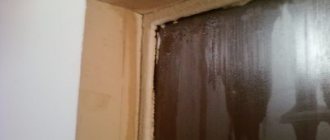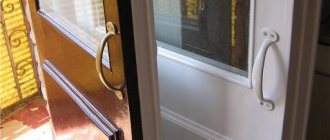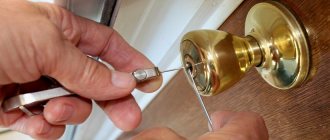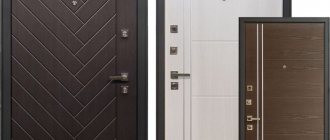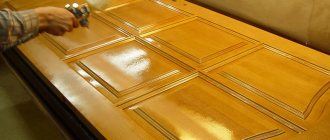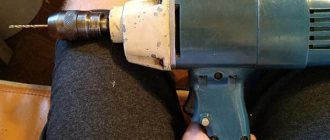What is an entrance door lock cylinder?
The lock cylinder serves to transmit force from the key to the door mechanism.
The most popular are English locks, that is, those with a cylinder type of secret mechanism (cylinder). This element serves to transmit force from the key to the door mechanism. The cylinder can only activate the bolt when the corresponding key is inserted into the hole, which the secret system recognizes as “its own” and begins to rotate.
The cylinder mechanism has an elongated shape, so in simple terms it is also called a larva, secret, etc. The popularity of such locks is explained by the fact that they are easy to maintain; opening them does not require much effort and the key is small in size. If the cylinder fails, it can be quickly replaced, without requiring disassembly of the entire lock or its complete replacement.
Installation
But besides how to remove the cylinder from the front door lock, you need to insert it back. With this procedure the reverse process will be followed. Before installation, it is recommended to inspect and compare the purchased and broken larvae. They must not only have the same size, but also the positions of the mounting hole and tongue must be at the same level.
It is necessary to turn the movable tongue using a key or flywheel, and then insert the purchased cylinder into the well. It is necessary to hit the bolt correctly, so during the procedure it is necessary to move the core a little. If the bolt gets into the hole, the movement of the cylinder will immediately stop. Getting a bolt in is quite easy because almost all the holes are countersunk.
Types of lock larvae
The cylinder is the core of the lock, consisting of a keyhole, several parallel code channels - springs with pins are inserted into them. Only at a certain position of each of them is the cylinder able to rotate and unlock the bolt. The notches and teeth on the key are responsible for lining up the pins in the desired position.
The larvae in modern locks are available in 2 types:
- double-sided - the core is unlocked with a key from both sides of the blade;
- one-way (with a turntable) - the door opens and closes from the inside without using a key (using a rotary handle).
Also, larvae are classified into 3 types according to the level of burglary resistance:
- Low - the pins allow for up to 10 thousand combinations, the pins are made of wear-resistant brass. Doors made in China are often equipped with such mechanisms.
- Medium - up to 50 thousand combinations are provided, but the material is still wearable and not durable.
- High - the number of combinations is over 100 thousand. The lock is made of high-quality materials - a brass body, hardened or magnetic pins. Protection against knocking out and drilling is provided.
Cylinder mechanisms are popular due to their ease of operation and maintenance. If the cylinder fails, there is no need to disassemble the entire lock and replace it with a new one - just remove the old core and install a working one.
Is it worth changing the core yourself?
The main criterion when choosing a cylinder security mechanism is the degree of burglary resistance. To ensure the secrecy of the cylinder mechanism, spring-loaded or floating steel pins are used. Conventionally, according to the degree of burglary resistance, they are divided into:
- Simple. They have a low level of privacy, all pins are located in the same plane in one or two rows. Such larvae can be opened with a bump key in a couple of minutes. The door can be opened with a key from any side.
- Combined. The presence of secret elements in the form of holes significantly complicates a hacking attempt. In common parlance, the combined devices are called “spinner keys.” This is due to the fact that the door can only be opened from the outside with a key. From the inside - with a rotary turntable.
- Semi-cylindrical. The keyhole is located only on the outside, so such locks are practically not used in private households.
In order to replace the core yourself, you need to have certain practical skills. It is important to determine the type and size of the core. Having dismantled the old lock core, measure the dimensions of the mechanism: L, B, Ø. A cylinder of suitable size is inserted into the door, turning the cam to the “closed” position. Next, fix it with a special fastening bolt. Despite the apparent simplicity of the operation, it is better to entrust core replacement to specialists. Unprofessional installation leads to jamming of the lock, and the lack of specialized tools and replacement skills significantly increases the labor intensity of the process.
Adviсe
When a problem appears, it usually takes a person by surprise. Therefore, you need to calm down, assess the situation and go to the store for a new larva. There are only a few points you need to pay attention to.
- Secrets, like locks, come in different sizes. They can differ not only in diameter, but also in length.
- In a hurry, we must not forget about the required color of the cylinder, otherwise the castle will look ridiculous.
- Cylinder security mechanisms are different: some of them have a key hole on both sides, others have only one, located outside, and a turntable is provided for closing from inside the apartment.
- Not every cylinder will suit every key; here you need advice from an experienced seller.
It is necessary to avoid purchasing Chinese-made larvae, since their material is fragile and they quickly become unusable.
Reasons for replacement
It is necessary to replace the locking mechanism cylinder if:
- The lock is worn out and it becomes difficult to unlock. The shelf life of cores from Turkish or Chinese manufacturers is 3-5 years, from European ones – up to 10 years.
- The mechanism is broken or damaged - for example, due to burglary attempts or careless use of the key.
- The lock on the premises was opened.
- The locking mechanism jams, and the key has to be “swinged” when inserted.
- Keys were lost or stolen or were used by strangers.
- The owners and tenants of the premises have changed.
- It was decided to change the lock to a more reliable model.
Attention! It is recommended to replace the cylinder at the first sign of a malfunction. Even small errors in operation can cause the door to lock. In this case, it is often necessary to take drastic measures - especially if children or incapacitated citizens remain locked in the premises.
Replacing the working larva
Before replacing the core, you need to buy a new larva - it must be the same size as the old one. It is recommended to purchase the item from the same brand. If you buy at random, there is a high probability that the cylinder will not fit.
Don't miss: How to open any intercom without a key - recommendations from experts
Step-by-step instruction:
- Remove the armor plate from the door and unlock the lock with the key.
- Remove the screw from the end of the door and remove the plate.
- Insert the key into the hole and turn in the closing direction to release the bolts.
- Remove the screw in the center of the mechanism.
- Pull out and install a new larva - to fix it, carry out the steps in the reverse order.
Check the success of the manipulations with the door open to avoid blocking. The movement of the new core should be smooth, without extraneous vibrations or rattles.
We pull out the larva without a key
If there is no key to the door, but you need to pull out the cylinder, then you need to find another way to turn the pin. If there is no need to protect the lock, then the pin can simply be broken. In this case, the lock is knocked out or broken out. The door leaf will not be damaged in the process; the lock will have to be completely replaced.
There are other ways to dismantle the cylinder without a key:
- Drilling allows you to remove the lock cylinder without a key quickly enough, but it will be hopelessly damaged. Insert the drill into the keyhole and turn on the drill. You need to drill out to approximately the middle of the lock, that is where the pin is located. Usually after this the pin rotates inside the lock on its own, but sometimes it becomes necessary to push it there manually. This can be done with a thin knitting needle.
- Bumper key or master key. This option is more humane, since it allows you to open the lock and remove the cylinder without destroying it. But without special skills, this can take a lot of time.
If you are unable to dismantle the cylinder without a key yourself, you can contact a service that performs emergency opening of locks.
Cylinder lock and its core
The cylinder lock came to us more than 100 years ago from England. Such locks are the most popular among consumers; they are often chosen for installation on a metal door. A cylinder lock is almost impossible to pick using a master key.
There are often situations when the door key is lost or the lock breaks, but there is no need to rush to buy and install it on the door.
Cylinder locks are often chosen for a metal door
You can change its code part, in everyday life the lock cylinder.
The lock cylinder is the secret part. When the key is in the lock from the outside or inside, the cylinder is fixed. If necessary, you can easily replace it. Buying it is also not difficult, since many larvae are universal - for most manufacturers they are interchangeable.
The cylinder is broken: how to open the door. Methods and tips
If the lock did not receive timely repairs and failed you, leaving you in front of a locked door, there are several ways out of the unpleasant situation.
Emergency removal of the lock cylinder
- Try to get into the house through the window. Not suitable for apartments located in high-rise buildings.
- Dismantle the entire structure, including the frame. To do this, you need to remove the linings and frozen pieces of polyurethane foam around the entire perimeter of the opening and saw through the places connected by welding using a grinder. To apply this method, you need to have the appropriate tool at hand.
- You can also use a grinder, but only for cutting out the lock. This is quick, but in the future it requires replacing the entire entrance structure.
- Call the rescue service or the company that installed the door. It will take time to call and work with specialists, and sometimes you may need documentation confirming your ownership of the house.
There are ways that allow you to open a broken lock with the least loss:
- Using a pin, paper clip or wire. Break the improvised master key into 2 parts. Insert one into the lock and try to turn it, while simultaneously moving the pins away with the other part. Does not work with all types of mechanisms.
- A screwdriver. Effective for cross lock. After unscrewing the top, drill a hole above the keyhole, insert a screwdriver and turn it.
- Drilling out the lock cylinder. Not suitable for those structures that are equipped with powerful armor protection linings.
Advice. To ensure that the lock functions properly, lubricate it regularly and do not insert foreign objects into it. Do not slam the door to avoid the possibility of it deforming or warping. By following these rules, you will significantly extend the life of the locking mechanism.
Tips: how to remove the cylinder from a lock without a key
There are times when you need to replace the cylinder in a lock without having a key. Disassembling the lock and removing the core is a little more difficult, but quite possible.
First, you need to remove the bolt from the end bar of the lock (in the middle of the bar) and try to remove the cylinder. If it doesn’t work, then we solve the problem with the lock.
Options for removing door lock cylinders:
- First, try to turn the cylinder (look at the cutaway photo of the cylinder). To freely rotate the cylinder, the pins that interfere with them must be lowered. To do this, drill a hole under the cylinder with a 3 mm drill. They will fall and the cylinder will rotate. You can completely shoot the cylinder with a drill, not the easiest, but still effective method.
- This method involves removing the core without turning the flag. To do this, you need to remove the lining from the door, and try by all means to get ahead of which direction the flag is turned. Then drill out the lock body to remove the cylinder. This will not affect the operation of the lock.
- Well, the last way is to get it in parts. The cylinder is weakest in the middle, where the flag is located and the bolt is screwed in to secure it in the lock. You can break the core with a gas wrench by turning it clockwise and back.
Disassembling the lock and core is not easy, but it is possible
After the cylinder is broken, you need to carefully remove all parts from the door lock. Remaining pieces may interfere with the installation of the new core.
If you have repeatedly encountered the cylinder jamming, it is worth disassembling the entire lock and seeing if some part needs lubrication or repair.
Features of removing the cylinder on a damaged lock
It’s easy to remove the larva with your own hands:
- At the end of the lock, unscrew and completely pull out the screw holding the secret mechanism in the lock.
- The key is inserted into the hole and turned so that the pin is aligned with the body, that is, the secret is open and does not interfere with removing the cylinder; you need to turn the key 10-15%.
- By pulling the key, which cannot come out of the cylinder, it is removed along with the cylinder from the lock.
Don't miss: ENTRANCE DOOR SIZES: WITH AND WITHOUT FRAME, WIDTH AND HEIGHT STANDARDS
There is an armor plate on the outside of the door, so it is easier to pull out the cylinder from the inside.
If the key won't turn
In the case of the ignition switch, everything comes down to the same scheme: disassemble the lock as much as possible. Then you need to knock out the stopper pin and remove the mechanism. In extreme cases, you will have to drill it and then knock it out.
We recommend: To prevent the bottle from harming your health: choose a safe container for water and drinks
Tricky trick
Most often, the key in the ignition switch stops turning for three reasons:
- grease abrasion;
- clogging with dust (solved by washing with WD-40 or other car cleaners);
- metal fatigue.
For reference, a cylinder lock is based on a series of pins (pins), consisting of two halves and running up and down on springs. To open the lock, you need to place all the pins at a given height, that is, so that they fit exactly into the recesses of the original key.
Over time, the springs weaken and stop lifting the pin. Such a “tired” element can simply be removed from the lock - the car will start again, and with the original key, so there is no need to change all the locks in the car. If more than one pin is broken, then dismantling is only a temporary measure, because such a car will start with any third-party key.
Door locks
Very often the key does not turn in the car door because it is rusty (it was rarely used) or frozen. The first can be solved with a rust converter (it will take quite a lot of time), the second can be solved by heating.
How to avoid door problems
To prevent this from happening, it is worth taking periodic preventive measures:
- Lubricate the part with special oil several times a year;
- To make the mechanism last longer, you should not slam doors;
- Outdoor external locks should be regularly cleaned of debris, dust and dirt that fall inside from wind and rain.
If you were unable to open the door yourself, there is no need to break it. Call customer service and they will help you quickly.
When to change the lock
The time to replace the cylinder in a door lock comes not only after noticeable structural faults or loss of the key. There are other reasons that make you think about the need for a quick procedure.
First you need to assess the condition of the locking mechanism core using a number of signs. If you don’t see the problem in time, then one day the door will simply be blocked. The situation will be fatal, since a breakdown may occur at the wrong time.
Cylinder types of locks have fine mechanics. Even minor wear of one of the parts can cause a malfunction of the locking mechanism. The pins will not rise to the desired height, preventing the cylinder from opening. Pay attention to the key. It is usually made from a material similar in hardness to parts of the larva. It is easier to understand the wear and tear of the structure if the door can only be unlocked with one key. When there are several of them in the house, this factor should be taken into account.
To determine the degree of wear of a key, compare it with an unused set. Please pay attention to the following parameters:
- Form.
- Sharpness of edges.
- The height of the indents.
- Coating.
In Chinese models, according to statistics, the lock cylinder is replaced every 5 years. European analogues have a longer shelf life - up to 10 years.
| Advice! The new cylinder should have the same dimensions as the old one. This concerns the length of the element, the distance from the edge of the cylinder to the rotating mechanism. Write down these parameters, and then select a new part. |
The English larva is a mechanism that does not stop working at a specific moment. Signs of failure may appear even before the product fails completely. So, the cylinder can jam half a turn. To tighten the key all the way, you need to wiggle it. You should be wary if extraneous sounds appear when opening the door leaf - creaking, clanging, grinding, crunching. Most often, in such a mechanism, the cam of the larva breaks, which takes on the main load.
How to remove
If there is a key and it opens the lock on at least one side, then the process of replacing the cylinder is simple and quick. When the key is lost or broken in the cylinder and its pin holds the bolt in the closed position, it is much more difficult to pull it out without a key, but it is possible.
Knocking out the larva
This method leads to damage to the lock, so it is recommended to resort to it only in the most extreme situations. To do this, use a chisel, the width of which is slightly less than the core of the lock, and a hammer; with their help, blows are applied to the core until it is mechanically destroyed, until it can be knocked out. When access to the lock bolt appears, it is moved aside and entered into the room. In this case, not only the locking mechanism is often damaged, but also part of the door leaf.
Breaking out the larva
The principle of this method is that, using an adjustable wrench, the larva is securely fixed and then sharply turned. The core fastening is damaged and it can be removed from the lock. This leads not only to its damage, but also to breakage of the lock, but the door leaf remains unharmed.
Reaming the larva
Compared to previous options, this one is more humane, but it also damages the secret mechanism, which can no longer be used once removed.
The drill is inserted into the key hole, after which the secret is drilled out at least half the length to damage the pin. When it loses contact with the bolt, the lock can be unlocked and the doors can be opened.
Using a master key or bumper key
Although this method is the safest, it requires appropriate skills to use it.
Using a master key requires not only free time, since the process is lengthy, but also knowledge of the structure of the larva.
It has several pins that are spring-loaded, and in order to rotate the mechanism they must be raised to a given height. The better the quality of the lock, the more such pins it contains and the more difficult it is to open it with a master key.
Curved and straight wire is used. The first one tries to set the pins in the desired position, and the second one tries to rotate the cylinder. Instead of wire, you can use a sharpened metal file.
The bumper key has a large number of grooves and allows you to place the pins in the desired position. First, such a key is inserted into the keyhole, then pulled out one pin and sharply hit on the key, after which it is immediately turned.
How to understand that the cylinder can be changed in the lock
The cylinder lock cylinders from all manufacturers are interchangeable. This is due to the fact that they are made to the same standard. You need to choose a mechanism based on the thickness of the door where the lock is installed. After installation, the part should not stick out.
You can determine for yourself whether it is a cylinder lock or not by looking at the shape of its key. It will be flat with cutouts or small notches; there are semicircular keys with notches; there are cross-shaped models with notches on all sides.
There are 2 types of cylinder locks:
- With turntables. Then there is no keyhole on the inside of the door, but only a turning mechanism for opening and closing the lock.
- No turntable. The products come with keyholes on 2 sides.
| Advice! Lever locks have 4th class of reliability. As a rule, class 3 or 4 locks are used on metal front doors. |
When the key at the end has 2 blades in a single plane, which are directed in different directions, then we are dealing with a lever lock. With a mortise lock, that is, the mechanism is installed in the body of the door leaf, the cylinder can almost always be replaced with your own hands. The proof is the presence of a screw at the end of the lock just under the latch.
Don't miss: DIY door opening design and decor
When selecting a new larva, the most correct thing to do is to make a purchase according to the sample. Take the used element. First, compare its dimensions - diameter and length, and then look at the mounting holes. It is recommended to purchase a device with better privacy and reliability characteristics than the previous one. Choose the one with more keys.
Where can I buy a lock cylinder?
- In the household department, but the assortment there is often poor and there is no required size.
- Contact the service center of the manufacturer of your front door. They will help and advise. The only problem is that not all cities have it.
- Through an online store. There is always a large selection of goods.
In some locking designs, it is impossible to remove the lock cylinder from the front door. Then you will have to pull the entire mechanism out of the door. In this case, purchase the option where you can change the cylinder in the lock in the future.
The new key for the home door must match the profile of the entrance hole in the lock.
Removing the Lock Core
After taking measurements, you can proceed directly to extraction.
It is best to entrust the replacement to a master, if possible Source masterslock.ru
The procedure for changing the cylinder in the front door lock includes only 3 steps:
- Unscrew the bolt located at the end of the door. In some cases there are two of them at once. They are located above and below the crossbars. The bolts must be completely removed.
- Insert the key into the cylinder and turn it 10-15 degrees. This is enough for the tongue and body to be on the same level. Otherwise, it will be impossible to remove the core.
- Now you need to grab the key and pull out the larva. In this position, the key will not move, which will make it easy to complete the operation.
Most often, the core is pulled out from the inside of the door. The reason is that many locks have an armored lining that does not allow the cylinder to be pulled out to provide greater security when trying to break into the mechanism. But there are also those models in which the core only comes out. This scheme is applicable mainly to locks that have a special decorative lining on the inside, which does not allow the system to be easily dismantled from the apartment side.
The process of unscrewing a bolt and removing the core Source www.rmnt.ru
How to choose a lock cylinder
Before changing the lock on a metal door, you need to know the size of the cylinder. To do this, the structure is opened, the element is pulled out so that it is convenient to pick up an analogue in the store. Almost all sizes of larvae are standard. The diameter is 17mm, but the height is 33mm. Such indicators are found not only in the most affordable brands Apecs or Kale, but also in more serious companies like Abloy and Mul-T-Lock.
Standard dimensions allow you to install products from different manufacturers into any cylindrical lock. At home, you can not only replace the larva with a new one, but also complicate the mechanism, which will be difficult to open. There are few locks with non-standard DIN left in stores anymore. It is better to replace such parts with new ones.
If the height and diameter are the same for most models, then the length of the larva is different for each manufacturer. Trace the outline of the item on paper before purchasing. At the end, mark the hole where you will need to insert the key. You can also measure all dimensions of the mechanism.
| Advice! If you feel difficulty turning the key, then the problem is that the loan cylinder was installed incorrectly. To do this, unscrew the screws again, pull out the element, and then reinstall it. |
If you buy a cylinder where the cylinder protrudes beyond the door, this will reduce the protection of the lock completely. It’s easy to break into such a door; just knock out the cylinder. It is better if this element is recessed into the door.
Avoid purchasing larvae with a flywheel. Such models easily fall into the hands of criminals. But such mechanisms are useful for interior doors. The apartment can be easily broken into by drilling a hole. Next, the swindler's hand reaches through the door to start the flywheel from the inside.
How to remove the larva from the lock with your own hands
In everyday life, we often come across locks. There is not a single person who does not carry at least one key with him. There can be many reasons for changing the lock. Whether it's losing a key or jamming a lock. It is not always necessary to change the entire lock on the door. Sometimes it is enough to replace just the code part of the cylinder lock - in other words, the cylinder. It will be cheaper and won't require much effort. Disassembling the lock will take no more than 10-20 minutes.
In order to remove the broken cylinder, you will need a screwdriver and a key.
First you need to understand that the larva is held in place by just one bolt. We determine its location. Draw a line from the keyhole to the end of the door, where the bolts are located. There will be a bolt just below this line, and you need to unscrew it.
To remove a broken cylinder, you need to prepare a screwdriver and a key
If you don’t get the larva right away, the key will help. You need to insert it into the lock and turn it a little.
The flag on the larva will fall into place, and it can be easily removed. After that, you can go to the store with it and pick up an identical one. The reverse procedure for installing the core is not difficult.
How much does it cost to change a lock cylinder?
The price for installing a new security mechanism depends on the type of locking device, the complexity of its opening, design features, the need to disassemble the door and other factors. Thus, the price of replacing the lock cylinder of the front door without the need to disassemble the door starts from 900 rubles. If intervention in the design of the door leaf is required to change the cylinder, the cost of the work starts from 1,400 rubles.
| Prices | |
| Russian castle | from 1400 ₽ |
| Imported lock | from 1800 ₽ |
If something happened to you with a door lock or any of its components, then you are now exactly where they will solve this untimely problem for you as quickly, efficiently and inexpensively as possible!
Sources
- https://tekstil-doma.ru/sredstva/kak-vytashchit-lichinku-bez-klyucha.html
- https://HoroshijPotolok.ru/otdelka/kak-vysverlit-lichinku-zamka-vhodnoj-dveri-poshagovaja-instrukcija.html
- https://verydveri.ru/furnitura/kak-pomenyat-bez-mastera-lichinku-v-dvernom-zamke.html
- https://ekb.tbmmarket.ru/help/useful-articles/item/4917/kak-pomenyat-lichinku-v-zamke-vkhodnoy-dveri/
- https://zammaster.ru/zamena-lichinki
[collapse]
Post Views: 1,183


